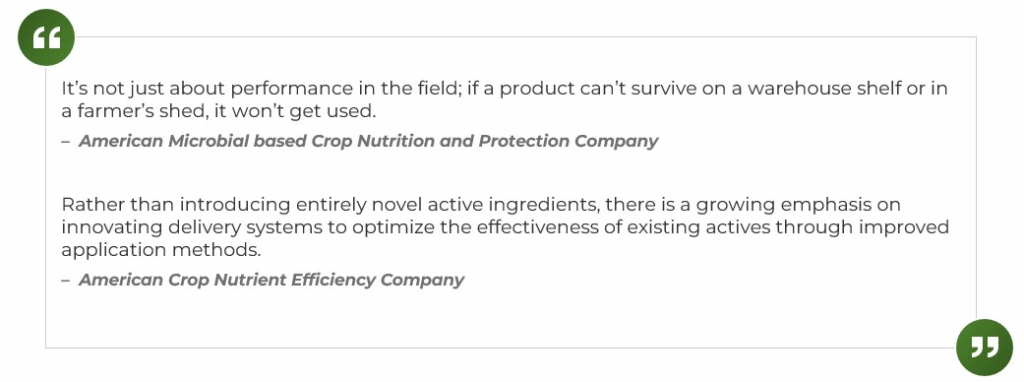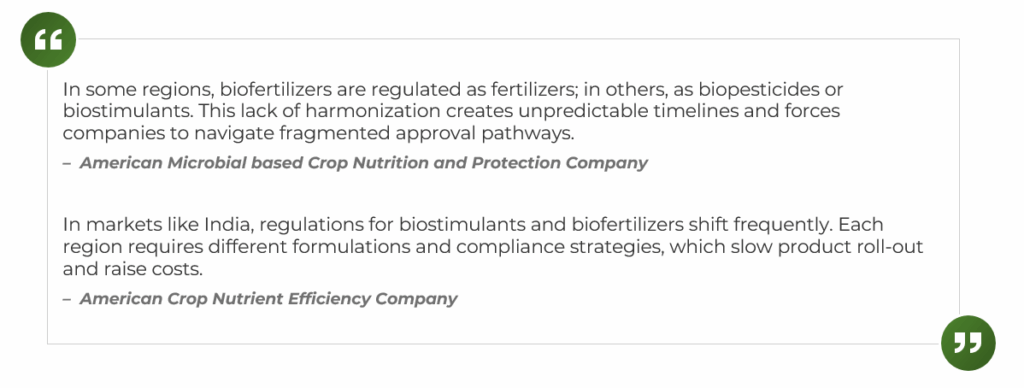Lux conducted a series of interviews with industry stakeholders to ascertain both affirming and conflicting perspectives on the technological and commercial development of biofertilizers, while uncovering additional unmet needs and innovation opportunities required to further advance the technology. The voice-of-industry interviews are designed to provide additional insight to Lux’s analysis, and quotes included in this research brief have been edited for coherence and brevity and don’t necessarily represent Lux’s opinion.
Biofertilizers are emerging as a critical tool to improve soil health, enhance nutrient efficiency, and reduce reliance on synthetic fertilizers. Investment and policy support have advanced microbial strain development, formulation technologies, and delivery methods. However, Lux’s industry discussions highlight persistent technical and commercial bottlenecks in product consistency, compatibility with conventional inputs, regulatory clarity, and farmer adoption. Solutions remain slow to scale due to fragmented standards, limited agronomic validation, and inadequate training for startups and advisors on field-level challenges. Realizing biofertilizers’ potential will require coordinated efforts that align microbial science, robust formulations, regulatory frameworks, and farmer education, supported by stronger industry collaboration.
Inconsistent performance and lack of standardization limit trust in biofertilizers.
Biofertilizer efficacy varies widely across geographies, crops, and soil conditions due to interactions with soil microbiomes, nutrient availability, and environmental stresses. Even well-characterized strains often fail to colonize roots consistently, creating unpredictable nutrient delivery. Formulation stability, pH shifts, and exposure to UV or temperature extremes further reduce microbial viability before application. Unlike synthetic fertilizers with standardized nutrient content, biofertilizers lack harmonized metrics for potency, colony-forming units, and field performance. This absence of standards prevents growers from comparing products, assessing shelf-life, or calibrating application rates with confidence. The resulting trust gap between developers and users continues to slow adoption.

Many stakeholders highlighted a disconnect between lab results and field performance, creating a trust gap with farmers. Variability in microbial survival, formulation shelf life, and delivery mechanisms also contributes to inconsistent outcomes. Shelf-life limitations compound the problem. Most formulations lose viability after 6–9 months, especially in high-heat storage conditions, discouraging distributors from carrying inventory.

Compatibility with conventional inputs and farm equipment is a significant hurdle.
Most biofertilizer products cannot withstand the chemical and physical stresses of conventional farming systems. High-salt concentrations in NPK fertilizers create osmotic stress that lowers microbial viability, while co-applied agrochemicals, including fungicides, insecticides, and herbicides, can be directly toxic. In fertigation, residual chlorine and pH swings further destabilize microbes. Equipment also poses risks: Suspensions sediment and clog drip lines, and microbes degrade under shear forces in pumps or sprayers. Granular and coated formulations face drying steps that kill microbes and coatings that fail to protect against heat or moisture during storage. Without robust encapsulation, protective carriers, or stress-tolerant strains, most biofertilizers cannot reliably survive integration into conventional input mixes and equipment. This technical gap makes true “plug-and-play” adoption difficult.

Many microbial strains cannot withstand the chemical environment of conventional nutrient mixes or pesticides, making co-application a persistent challenge. Equipment factors, from pumps’ shear forces to drip irrigation sedimentation, further reduce viability, especially for non-spore-forming organisms. The lack of standardized testing protocols for tank-mix or co-application compatibility also limits confidence among agronomists who advise farmers.

Regulatory ambiguity creates go-to-market challenges.
Regulators classify biofertilizers inconsistently across regions. Some markets treat them as fertilizers with basic nutrient-value requirements, while others regulate them as pesticides or biostimulants, which demand rigorous safety and efficacy reviews. This lack of harmonization complicates multinational product launches and forces companies to redesign compliance strategies for each jurisdiction. Startups and small to medium-size enterprises struggle with delays because regulators provide little clarity on trial protocols, data requirements, or review timelines. Key questions remain unresolved: What proof of efficacy will regulators accept? Will single-season data suffice? Are multi-year or stress-tolerance trials necessary? How are microbial consortia evaluated, as single products or multiple active agents? These uncertainties raise costs and extend time to market for developers while delaying farmer access to valuable tools. Until regulators establish clearer global standards, regulatory ambiguity will slow investment, complicate scaling, and prevent innovative biofertilizers from reaching mainstream markets.

Farmer adoption lags due to education gaps and economic uncertainty.
Growers express interest in reducing synthetic input use but remain uncertain about the economic return on biofertilizers, particularly without yield guarantees or subsidies. There is also a persistent knowledge gap among growers and agronomists on how and when to apply biologicals. Limited access to trusted, independent field trial data reinforces this hesitation, as most farmers rely on peer experience or local advisors before making changes. Adoption will remain incremental rather than transformative without tailored training programs and clear demonstrations of cost effectiveness under real-world conditions.

The Lux Take
Fertilizer, seed, and crop input companies should co-develop biofertilizers with partners that can prove compatibility with existing systems, economic ROI, and real-world consistency. Adoption hinges on seamless integration, with near-term wins in regional trials and delivery innovations, and long-term gains tied to farmer trust and alignment with policy and carbon markets. To stay competitive amid sustainability and pricing pressures, companies must shift from tech-push to performance-driven partnerships that deliver verified value.
